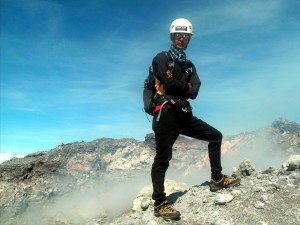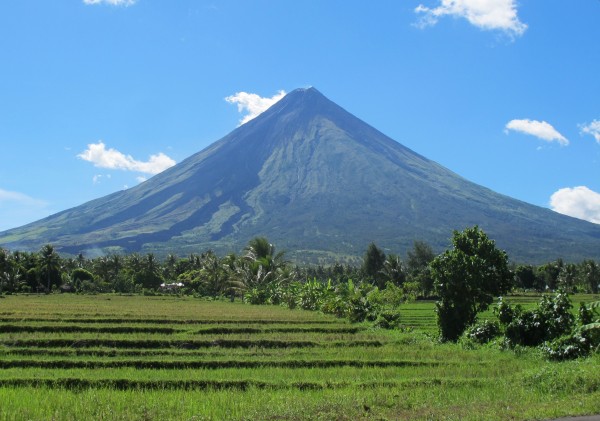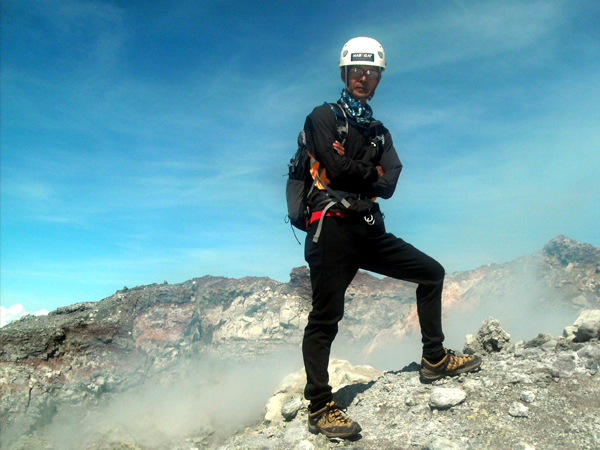
LEGAZPI CITY—He first climbed Mayon Volcano when he was 17.
After 35 years and more than 300 climbs, George Cordovilla, now 52, is still climbing this mountain with the same energy and passion he had when he was younger.
There’s something magnetic about Mayon that inevitably pull climbers and mountaineers to it, he said.
“Mayon is like a diamond. It has many facets. It’s always different,” said this local tour guide.
An imposing 2,462 meters tall, Mayon Volcano is surrounded by six towns and three cities in Albay province and has often been described as the Philippine volcano with an “almost perfect cone.”
But the volcano’s serene beauty is deceptive. It has erupted at least 50 times, the most destructive being in 1814 when at least 1,200 people perished.
Mayon’s most recent eruption happened on May 7 this year, a phreatic (steam-driven) explosion that killed five people—four European climbers and their Filipino guide—and injured at least 10 people.
Volcanologists classify Mayon as an active volcano, which means that even if no alert has been declared, the possibility of it erupting is always there.
After that May incident, state volcanologists raised Mayon’s alert level to one, which means that it is in an abnormal state.
This also means that climbing and entering the volcano’s six-kilometer Permanent Danger Zone (PDZ) is prohibited by the Philippine Institute of Volcanology and Seismology (Phivolcs) and the provincial government, since more phreatic explosions and ash puffs could occur.
But the advisory and previous explosions have not deterred people from enjoying Mayon’s majestic beauty up close, said Cordovilla, who added that people have their own personal reason for defying their better instincts to stay safe and at a distance from this site.

For him, climbing Mayon is his way of “communing with nature and with what God has created.”
Getting closer to Mayon also relaxes him and gives him a sense of fulfillment, he said, adding that such reasons spurred him to become an accredited Mayon guide for the Department of Tourism (DOT). He has been one since 1979.
Having conquered Mayon countless times for the past 34 years, Cordovilla knows the volcano like the palm of his hand.
There are many entry points to reach Mayon’s summit, he said, but the most commonly used are the trails in Lidong, Sto. Domingo town; Bonga in Bacacay town; and San Roque in Malilipot town.
Each climb usually lasts two to three days, depending on the strength of the climber and the weather. Those two factors also determine whether the climber would reach the summit.
Safety is a foremost consideration, said this tour guide.
“Before starting the climb, I always make sure that I orient my guests about it,” he said.
Next to Ricardo Dy, another guide who has scaled the volcano over 600 times, Cordovilla takes pride in having climbed Mayon so many times that a part of the Lidong trail was named after him. It’s called “George’s Steps.”
Cordovilla is part of the Mayon Naturalist Ecoguides Inc. (Manega), the group of accredited Mayon guides that was formerly known as the Mayon Outdoor Guide Association.
All 15 members of Manega have passed the “special interest classification” accreditation of the DOT and have undergone a basic mountaineering course that includes safety and fitness training.
All accredited Mayon guides are required to secure a visitor’s permit from the Department of Environment and Natural Resources before they can enter the Mayon Volcano Natural Park. Before the climb, they also have to check with Phivolcs whether it’s safe to do so at that particular time. Village officials must also be informed.
Cordovilla, the most senior member of Manega, said being a Mayon guide and earning from it is a challenge that can be as formidable as the volcano.
While guest bookings are usually high during summer and sometimes in December, deteriorating weather conditions in other months make climbing hazardous. Even climbing in December, when rains become a possibility, can be a touch-and-go event.
The seasonal nature of their trade makes it difficult for guides like him to make a decent living, Cordovilla said. Everything depends on the season, the weather and the status of Mayon.
Added to their already slim pickings is the considerable burden of having to spend for the climbing gear: shoes, clothes, raincoat and helmets that can easily run into thousands of pesos.
Foreign tourists often do not have climbing gear, Cordovilla said, so the rent for this is included in the tour guide rate, which ranges from P2,500 per person (for Filipinos) to P6,500 for foreigners, plus an additional P500 for extra persons for a two- to three-day hike. A guide is allowed to have up to five guests per climb.
The guide fee can also include the fee for porters who can be hired to carry heavy stuff.
Guide fees may be lower among non-accredited guides, but the risks are greater because these colorum guides may not have the proper skills and training needed for a safe climb, Cordovilla said.
To survive their seasonal trade, most guides have other jobs to make ends meet, he added.
This was true of Jerome Berin, 23, the Filipino guide who died in the May 7 explosion.
Berin, of Malilipot, Albay, who worked as a merchandiser for a local grocery chain, belonged to another group of mountaineers who were not accredited by the DOT to offer guide services to Mayon.
But he worked as a part-time guide to save money for his wedding to his partner, with whom he had a 3-year-old daughter. Their wedding had been set for June 15 this year.
Berin’s story became doubly tragic because his family cannot claim insurance, Cordovilla said. No insurance company would accept Mayon guides as clients because of the risks involved, he added.
Guests are asked to sign a waiver as well, stating that they are aware of the risks involved in their climb and that guides would not be held accountable for untoward incidents during the event.
There can’t be any finger-pointing, he said, because it was both the climbers’ and the guide’s decision and choice to climb Mayon.
“If you don’t want to take the risk, don’t climb (Mayon),” he added.
The risks involved in climbing the volcano can never be underestimated, said this veteran guide. “Mayon is by nature unpredictable. Anything can happen,” he said.
According to Cordovilla, it is not just the volcano’s eruption that can cause accidents, injuries and even death.
Climbers may also get hit by dislodged rocks, or they could slip and fall from slippery trails or simply get lost. There are also trails where climbers must use ropes because of the steep incline, usually 60 to 80 degrees.
That’s why he always starts his climb with a prayer, Cordovilla said.
“No matter their religion, I always ask my guests to pray with me to ask God for protection and strength,” he said.
Cordovilla was there when Mayon had a phreatic explosion on May 7. With him were four Thai nationals and four porters.
Some of them sustained injuries when hot falling rocks hit them, but luckily, they all survived.
“As a guide, it is our responsibility to keep our guests safe,” Cordovilla said. But it is also part of the guide’s responsibility to help in the rescue of guests and fellow guides when the situation calls for it, he added.
But rescuing people in distress around Mayon is “very different from what we see in the movies, which make it look so easy,” he noted.
Rescuers need special skills in rescue situations, Cordovilla said, otherwise, even their lives would be at stake.
Willingness is not a factor that the government considers when it chooses those who could be part of the rescue team, he said.
Rescues can be very costly and could take a long time because of many crucial factors, among them a difficult trail and bad weather.
Cordovilla said the best way to address the risks involved in climbing Mayon is to regulate it.
Albay Governor Joey Salceda was apparently of the same mind. Even before the May 7 phreatic explosion, the provincial government and its Tourism office were in the process of preparing an ordinance doing just that.
After the incident, Salceda said he would declare the existing six-kilometer PDZ surrounding Mayon as strictly a “No Man’s Land” even under normal conditions.
He said that the province would have to pass an ordinance prohibiting human activities in the PDZ, among them mountain climbing, all-terrain vehicle activities at the lava front, and even farming.
Cordovilla said he favors such regulations, although he believes it would be hard to prevent people from climbing the volcano because of so many existing trails.
But once the ordinance is passed, he said climbers and guides won’t have any choice but follow it. When that happens, people can only gaze and marvel at Mayon’s fatal charms from a safe distance. •









































